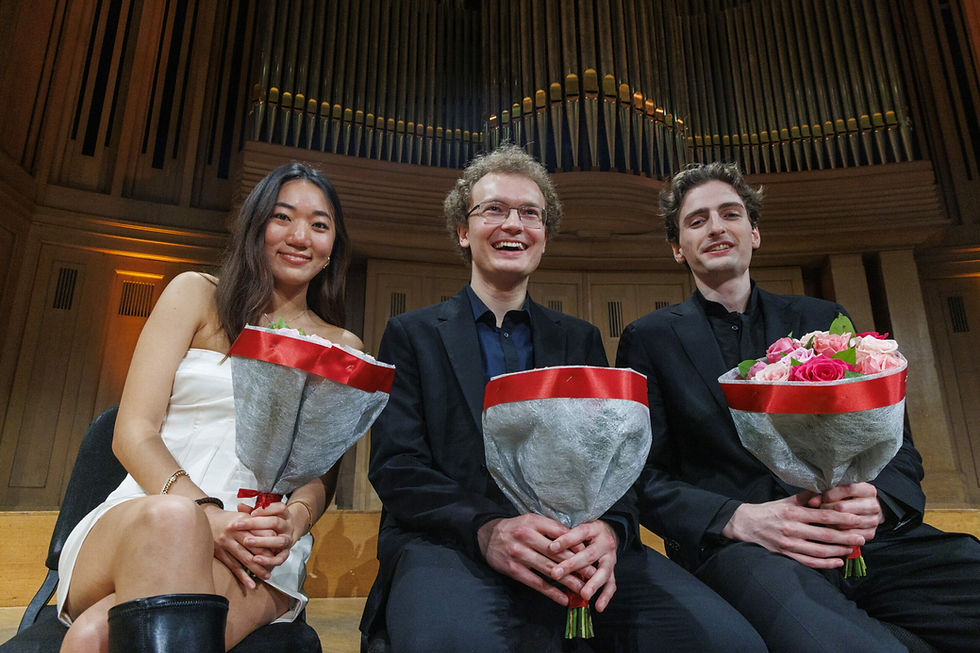Why music no longer belongs in universities
- Danger Dirt

- Oct 12, 2021
- 9 min read
Updated: Jan 23, 2022
Remember how I said that education is not the number one priority for universities and how that topic requires an essay of its own? Well — here is that essay. Strap yourselves in… because it’s going to be a long one. An insatiable capitalist system, driven by the surreptitious force of neoliberalism, is responsible for the slow corruption of one of the ideological pillars of society: the notion that free and accessible education is a human right. But even more than that, the virtues of critical thinking, liberalism, and academic freedom are on the line too. The sinking educational standards of Western universities poses threats to society at large across all disciplines. I would say that music, inherently a liberal pursuit, does not belong in Australian universities as they currently operate. Although the discipline of classical music without a doubt has tangible impacts on the wider community, including economical, other times its impacts are abstract and harder to calculate. There is a general consensus in the musical community that the value of classical music is almost impossible to properly measure, and that one could endlessly argue why it is valuable in relation to a host of other things. But the concept that music should be valued for music’s sake forms part of the Socratic ideals of a true liberal arts education, and these are higher moral ideals on which our entire education system is supposedly based. What is happening in universities today is therefore incongruous, and to investigate this further, we need only follow the money. Of course, the benefit of hindsight makes it easier to judge the decisions made by various governments over roughly the past 50 years. And these are highly complex issues with no simple answers. So in order to understand where we are now, it is important to know the history of universities in Australia and how they have changed. Here’s a brief run-down. The Baby Boomers enjoyed a free tertiary education, but as more and more “ordinary Australians” began to enrol in universities, their financial situations became untenable and in 1989 the Hawke government began re-introducing tuition fees. In the 1990s, government reforms were designed to foster cooperation between universities and industry. There was the introduction of Cooperative Research Centres, which saw more industry-driven projects with a high potential for commercialisation. Business leaders were invited to the table. From then on, I would argue, it has been a slippery slope. It is surprising that neoliberalism, a term which emerged in the 1980s, is not an idea which is often heard or discussed, and yet it is fundamental to every part of the way in which Western society currently functions. Commonly associated with the policies of Thatcher and Reagan, the intricacies of neoliberalism are manifold. But in short, the term encompasses the ideals of free-market capitalism: deregulation, privatisation, globalisation, free trade, and cutbacks in government spending in order to bolster the role of the private sector.

And so education was being privatised and monetised, and the shift towards teaching and research that is commercially funded, rather than that which is geared chiefly towards serving the community, left universities vulnerable to the values and agendas of external stakeholders. Naturally, it also led to a devaluing of activities which did not have the same commercial potential. According to the paper Academic capitalism and the entrepreneurial university: some perspectives from the Americas, universities “behave like businesses in the commercial marketplace and the influence of market forces on post-secondary education is stronger than ever before.” It continues, “Within the prevailing academic capitalist framework, support for faculty research has been diverted away from the arts and humanities and toward science and technology disciplines where breakthrough discoveries can be patented and sold.” The Grattan Institute’s 2018 report confirmed that this was also the case in Australia. With a decent portion of university revenue coming from academic research output, the report revealed, “The funding system also influences how academic freedom works in practice ... research expenditure has biases towards medical and scientific disciplines, and towards research with potential practical outcomes. Academics with other research priorities receive less financial support.” The astronomical rise of executives’ salaries and an ever-widening rift between the academic and executive branches of universities is also thanks to the reforms in the 1990s, according to the Grattan Institute. No longer places of education, universities morphed themselves into big business, and Vice-Chancellors became their CEOs. Today, education is Australia’s third-largest export (and the largest in the State of Victoria). Among the features of rising tuition fees and administration costs, there is an increasing perception that investing in education is not worth the return. And spiralling student debt is fast casting doubt on the argument of “equal opportunity”. KPMG’s findings in their report, End of a golden age for universities, sums up the fundamental problem that universities face. “Usually known as Baumol Cost Disease, it means that while universities need to cover costs that largely include paying competitive salaries to attract and retain sufficient talent, they are running out of productivity gains under their current operating model. Many have reached the point where creating larger classes and limiting subject choice are meeting consumer resistance.” “And the gloss has come off among some of those who have ardently supported higher education as both a force for good and as value for money. If it is so good for equity, why is income and wealth inequality rising? If students are paying all this money, why do they mainly see adjunct teachers, not tenured faculty members?” Before the pandemic, universities were on Struggle Street*, keeping their heads above water with international student revenue — the single largest source of revenue for public universities. It exceeded $9 billion in 2017, and was set to continue to rise. The Grattan Institute’s report stated, “Overall, most universities are in a sound financial position, but with flat government revenues they are vulnerable to a downturn in the international student market.” And then... the pandemic hit. The pandemic only fast-tracked what was an inevitable financial reality for universities. In 2020 the international student market did a spectacular nose-dive and domestic enrolments waned. In February 2021 Universities Australia released the news that the sector had lost 17,300 jobs in 2020, around $1.8 billion in revenue compared to 2019, and that it is expected to lose a further $2 billion in 2021. Then there came another blow in May 2021, when the Federal government announced that it will reduce funding to the sector by almost 10% by 2024. But what has all of this got to do with music? Well — the Arts have never fit perfectly well inside the modern university model, but the study of music is a particularly square peg. Let’s talk about the obvious: Music Performance. First of all, Music Performance is not an academic subject, it is practical, and therefore it does not produce any research. It is also the only subject which requires regular and intensive one-on-one teaching, every year of study. The use of resources to focus on one student at a time, the lack of tangibility in the outcomes of creative arts research, the ambiguity around the career prospects of music graduates — these are all reasons that universities increasingly see music as unnecessarily wasteful expenditure. And so they are gradually attempting to cut their music departments loose, as the Australian National University (ANU) tried to do in 2012.

The sacking of most of the instrumental staff at the ANU’s School of Music in that year was part of an effort to reduce a “$2.7 million deficit”. The ANU’s then-Vice-Chancellor, Ian Young, said that the budget cuts to the School of Music were put in place to make it more “financially sustainable … without being an unacceptable burden on the wider university community.” A bitter pill for the musical community in Canberra to swallow when the total in “saved” dollars amounted to almost that of Mr Young’s total annual income in his position at the time as a university executive. The cuts resulted in irreparable damage to the School, and to Canberra’s arts scene. The financial desperation of these institutions as a whole naturally causes unavoidable ideological conflicts of interest. How can an honest pursuit of critical thinking occur under such extreme economic pressure? The neoliberalist university model not only devalues disciplines such as the performing arts, but it also compromises academic freedom and exposes itself to dogma, even propaganda. In Australia, it soon became apparent that the heavy reliance on international student revenue came with other problems. In August 2019 a taskforce was established to counter what were reported as “unprecedented levels” of foreign interference in the Australian university sector. This came following many incidents of harassment, coercion and surveillance by pro-Beijing Chinese international students. There were also concerns over Australian universities’ collaborations with Confucius Institutes — educational and cultural promotion programs, funded by the Chinese government, which have been investigated over military and industrial espionage. There is currently very vocal backlash against the influence of China, but if education continues to be driven by the free market, who can say what subtle propaganda could insidiously infiltrate Australian universities? The analogy is over-used, but these are trends of truly Orwellian proportions. Over the past few decades, there has been a marked shift in the economical demographics of the political “left”. The result of the 2016 US presidential election was demonstrative of this, and while the political landscape in America is unique, this general change in wealth demographics is becoming a Western phenomenon. Today’s left, particularly the “white” left in Australia, is no longer working class — it is wealthier than the post-World War II left, and the left of the 60s. Why is this significant? It is significant because those who can afford higher education today are guiding the culture of the institutions in which they reside. And it is ironic that universities, once temples of true liberal thought and whose principal inhabitants have traditionally been left-wing progressives, are now places contaminated by left-wing dogma. It is difficult for progressives in 2021 to get their heads around the phrase “left-wing dogma”, because it seems to them an oxymoron. However there is no denying that it lurks everywhere — even in the study of music. J.P.E. Harper-Scott, Professor of Music History and Theory at the University of London, wrote an article entitled Why I left academia. He said “The short explanation for why I left academia is that I became profoundly disillusioned by it ... I would put the problem in this (Kantian) way: I wrongly supposed that universities would be critical places, but they are becoming increasingly dogmatic.” He continues, “Consider the following statement, which fairly well articulates an increasingly common view in musicology: Nineteenth-century musical works were the product of an imperial society. The classical musical canon must be decolonised. The statement, and the attitude that goes with it, are dogmatic by virtue of form, not content. It does not matter that the statement in the first sentence is one that I can assent to. It becomes dogmatic by virtue of the second sentence, which admits of no doubt, no criticism, no challenge.” Book-burning exercises such as those to which Professor Harper-Scott refers, which make no effort to understand things like context, history, and hundreds of years of culture, are becoming prevalent in universities today. Of course, political agenda — on whatever end of the spectrum — has no place in educational institutions, but the toxic economic environment allows this agenda to seep in and jeopardise academic integrity. There has been a change due to the Job-ready Graduates legislation, released by the government in 2020, which now means that tuition fees for arts degrees have increased. Strangely, this has made them the most profitable for universities. But classical music, particularly performance, has never been a highly commercial endeavour anywhere, let alone for universities, and this will continue to be the case. The study of music as a pure and noble pursuit in itself is being corrupted by the current university model because of market demand and pressures to yield immediate economic results. With the focus on things like “job-readiness” and “entrepreneurial skills”, music courses are now grossly oversimplified and watered down, catering to the lowest common denominator.

No university is a true exception to this. Courses are full of superfluous specialisations and majors, such as subjects like “Context Studies in Music and Critical Performance” (Monash University), “Commercial Music and Songwriting” (Elder Conservatorium of Music, Adelaide) and “The Art of Teaching and Learning Music” (Western Australian Academy of Performing Arts). “Popular Music” and “Music Business”, once only found in vocational training, are now common subjects across all universities. The course descriptions feature recurring jargon, revealing a bemusing obsession with ideas such as “cross fertilisation across disciplines” and “collaboration”. These ideas have already been part of music for hundreds of years, and the creation of these non-subjects only serves to dumb down the discipline of music as a whole.
As a result of these poor standards, music graduates are leaving universities far less equipped with the skills they need to survive as artists, and this has massive ramifications for Australia’s wider arts scene. Starved of the opportunity, standard and challenge they need, aspiring young performers who are serious about performance understandably decide to study abroad. The ones who remain in Australia end up more entrepreneurs than musicians.
It is clearer than ever that the higher education sector, unable to sustain perpetual growth, is beginning to buckle under the pressure of neoliberalism. The absurd marriage of business and education is at best ill-fated, and this creates a myriad of issues. Given the complexities of these now mammoth business enterprises, it is difficult to know how to satisfactorily remedy our falling educational standards in a general sense. But one thing is for certain: universities are contributing to an artistic wasteland in Australia. The study of music is an endeavour which requires absolute honesty and integrity, and it no longer belongs in these institutions if they are to continue down this path.
*It was brought to my attention, thanks to a very knowledgeable colleague, that although universities outwardly like to keep up the appearance that they are strapped for cash, this may not be entirely true. If you can stomach a read involving the numbers, James Guthrie’s series of analyses for The Campus Morning Mail of university accounts reveals that universities are squirrelling away much more than they claim (with ANU one of the worst players in a dodgy game).




Comments